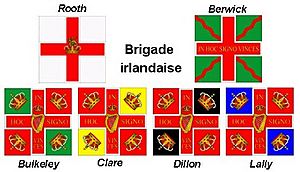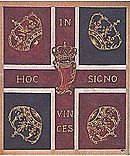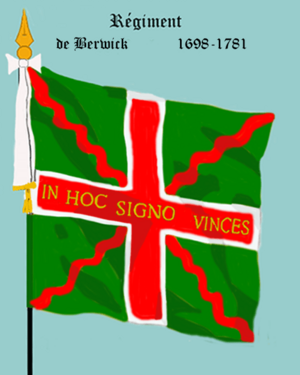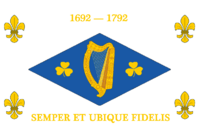Irish Brigade (France) facts for kids
Quick facts for kids Irish Brigade |
|
|---|---|

Regimental flags of the Irish Brigade.
|
|
| Active | May 1690 – 1791 |
| Country | |
| Allegiance | Kingdom of France and Stuart claiments to the thrones of Great Britain and Ireland (Jacobitism) |
| Branch | French Royal Army |
| Type | Infantry |
| Size | Three to six regiments |
| Motto(s) | Semper et ubique Fidelis (Always and Everywhere Faithful) |
| Colors | red |
| Engagements | Nine Years' War |
| Commanders | |
| Notable commanders |
The Hon. Arthur Dillon Justin MacCarthy Thomas Arthur, comte de Lally, baron de Tollendal, maréchal de camp |
The Irish Brigade (Irish: Briogáid Éireannach, French: Brigade irlandaise) was a special group of soldiers in the French Royal Army. These soldiers were Irish people who had left Ireland, and they were led by Lord Mountcashel.
The brigade started in May 1690. At that time, five Irish regiments who supported King James II (known as Jacobites) were sent from Ireland to France. In return, France sent a larger group of French soldiers to help fight in the Williamite War in Ireland. The Irish Brigade regiments were special foreign units in the French Army until 1791, when they became part of the regular French army.
Contents
How the Irish Brigade Started
When King James II went to Ireland in March 1689, his friend Tyrconnell ruled Ireland. The Irish Army was loyal to King James. At first, France didn't think it needed to send its own soldiers to Ireland. France's King Louis XIV needed his troops for the Nine Years' War elsewhere.
But the Irish Army struggled. They failed to win the Siege of Derry and lost a small fight called the Battle of Newtownbutler. So, Lauzun was sent to Ireland with 5,000 French soldiers. In exchange, Ireland had to send Irish troops to France.
The First Regiments
This exchange created the Irish Brigade in May 1690. It began with about 5,000 men in five regiments. Each regiment was named after its leader:
- Lord Mountcashel
- Butler
- Feilding
- O'Brien
- Dillon's Regiment, led by Arthur Dillon
The French army later reorganized these regiments. They combined the men from Butler's and Feilding's regiments into the other three. So, the main regiments became:
- Mountcashel's
- O'Brien's
- Dillon's
These three regiments formed the first Irish Brigade in France. They were known as Lord Mountcashel's Irish Brigade. They fought bravely for France during the rest of the Nine Years' War (1689–1697).
The Wild Geese Arrive
The Treaty of Limerick in 1691 ended the war between King James II and King William III in Ireland. After this treaty, about 12,000 more Irish soldiers who supported King James went to France. This event is famous as the Flight of the Wild Geese. These new soldiers were kept separate from the original Irish Brigade. They formed King James's own army in exile, paid by France. One regiment, Dorrington's (later called Rooth or Roth), was made from King James II's Royal Irish Regiment of Foot Guards.
Serving France
The Treaty of Ryswick in 1697 meant King James's army in exile was disbanded. However, many of its officers and soldiers joined the original Irish Brigade. These units served France well until the French Revolution. Other Irishmen, like Peter Lacy, joined the Austrian army on their own.
The Irish Brigade became one of the best units in the French Army. Over time, more French and other foreign soldiers joined. But the Irish officers and men often dreamed of returning to Ireland to help their homeland and get back their family lands. Some even did so during the Jacobite rising of 1745.
Major Battles
Irish regiments fought in most of the big land battles for France between 1690 and 1789. Some important battles include:
- Steenkirk (1692)
- Neerwinden (1693)
- Marsaglia (1693)
- Blenheim (1704)
- Almansa (1707)
- Malplaquet (1709)
- Fontenoy (1745)
- Battle of Lauffeld (1747)
- Rossbach (1757)
Helping the Jacobite Risings
Units from the Irish Brigade also took part in the rising of 1715 and the rising of 1745. For the 1745 rising, a special group of infantry called "Irish Picquets" was sent to Scotland. This group included soldiers from each Irish Brigade regiment. They landed with Richard Warren in October 1745.
This well-trained force fought at the second Battle of Falkirk. They helped secure the victory by pushing back the British (Hanoverians). They also fought at Culloden. As official soldiers of the French King, the Irish Picquets were able to surrender formally after Culloden. They were treated honorably and did not face the harsh punishments given to the Scottish clansmen.
Later Service
The Irish Brigade fought in the War of the Austrian Succession and the Seven Years' War. They fought in Europe and India. They also served during the American War of Independence. By the 1740s, fewer Irishmen were joining the regiments.
During the War of the Austrian Succession, the brigade grew from five to six regiments. The sixth was Lally's, created by Comte de Lally-Tollendal. Each regiment had about 685 men. The Brigade played a key role at Fontenoy, attacking the British. They suffered 656 casualties. At the Battle of Lauffeld, they had even higher losses, around 1,400 men. They led the attack that pushed the British out of Lauffeld village and won the battle.
During the American War of Independence, the brigade helped in several battles. These included the Capture of Grenada and the Siege of Savannah. Walsh's regiment helped the American cause. A group of their soldiers served as marines on John Paul Jones' ship, the Bonhomme Richard. Their motto, "Semper et Ubique Fidelis" (Always and Everywhere Faithful), might have inspired the U.S. Marines' motto, "Semper Fidelis."
Recruiting Soldiers
Before the Seven Years' War, the British government often ignored the quiet recruiting of Irishmen for the Brigade in Ireland. They saw it as a way to get rid of unhappy young men who might cause trouble. In 1729, France and Britain even had a secret agreement. It allowed 750 Irish recruits to join, as long as it wasn't made public.
But when the Irish Picquets helped the Jacobite rising in Scotland, the British realized the danger. They started to stop Irish recruits from joining French service. Recruiters caught in Ireland could be hanged. During the Seven Years' War, all British subjects serving France were called traitors. They could be executed if captured. However, this harsh rule was rarely used, unless a prisoner had first deserted from the British Army.
By 1789, just before the French Revolution, fewer Irishmen were directly joining the Brigade. It was hard to travel to France. Irishmen captured from the British Army during wars might be encouraged to join the Brigade. To make up for fewer Irish recruits, more Germans, Swiss, and other foreigners joined. Some Frenchmen also joined. However, the officers usually came from Franco-Irish families. These families had lived in France for generations, keeping their Irish names and heritage. Good military service helped these families become part of the French nobility.
Uniforms and Flags
The Irish Brigade wore red coats throughout the 1700s. Different regiments had different colors on their uniforms, like cuffs or collars. This helped tell them apart. Some people think the red coats showed their loyalty to the Stuart kings who claimed the British and Irish thrones. However, many foreign regiments in the French army wore red coats, like those from Switzerland.
The flags of the Irish Brigade often showed the Saint George's Cross. This showed their acceptance of King James III's claim to the English Crown.
Regiment Uniform Details
Here are some details about the uniforms of individual regiments:
- Buckeley Infantry: Red coat, collar, and lining. Dark green cuffs and waistcoat. White (pewter) buttons.
- Clare Infantry: Red coat and waistcoat. Yellow facings (cuffs, collar). White buttons.
- Dillon Infantry: Red coat and waistcoat. No collar. Black cuffs. Yellow (bronze) buttons.
- Roth Infantry: Red coat. No collar. Blue cuffs, lining, waistcoat, and breeches. Yellow buttons.
- Berwick Infantry: Red coat and waistcoat. Black collar and cuffs. White lining. Double vertical pocket flaps. Yellow buttons, six on each pocket flap.
- Lally Infantry: Red coat. Bright green collar, cuffs, and waistcoat. Yellow buttons.
In 1791, just before the Irish Brigade ended, new rules were made. All four regiments were given black facings, with only small differences to tell them apart.
Most of their flags showed their British Jacobite roots. Every regimental flag had the cross of St George. It also had the four crowns of England, Ireland, Scotland, and France. Nearly all the regiments' flags had a crown over an Irish harp in the middle. One exception was Roth's regiment. Its flag was a red cross of St George with a crown in the center and a crowned lion. It carried the motto In Hoc Signo Vinces (In this sign you will conquer).
Language Spoken
Some people believe that officers of the Irish Brigade shouted Cuimhnígí ar Luimneach agus ar fheall na Sasanach! ("Remember Limerick and Saxon treachery!") at the battle of Fontenoy in 1745. However, some modern research suggests it's unlikely most of the brigade would have been chanting in Irish, as many might not have known the language.
Others strongly disagree. They point out that over 100 years, many new recruits came from Irish-speaking areas, especially West Munster. Stephen McGarry's book Irish Brigades Abroad also says that Irish was widely spoken in the Irish regiments in France. Daniel Charles O'Connell, who was the uncle of famous Irish leader Daniel O'Connell, was the last Colonel of the French Irish Brigade in 1794. He rose to the rank of general. The O'Connells were native Irish speakers from an old Gaelic noble family.
French Army rules stated that officers of the Irish Brigade had to be Irish. Half had to be born in Ireland, and the other half born in France to Irish families. By the time of the French Revolution, most officers were from the second group.
End of the Irish Brigade
The Irish Brigade stopped being a separate group on July 21, 1791. The National Assembly ordered that all non-Swiss foreign units, including the Irish regiments, become "nationalized." This meant they were absorbed into the regular French Army as line infantry. They lost their old names, traditions, rules, and uniforms.
In early 1791, the Dillon Regiment became the 87th Regiment. Berwick became the 88th, and Walsh became the 92nd. The 92nd Infantry Regiment is still active in the French Army today. It has fought in the Napoleonic Wars, the Franco-Prussian War, and both World Wars.
Historically, members of the Irish Brigade had sworn loyalty to the King of France, not to the French people or their new republic. In 1792, some parts of the Brigade joined the Royalist forces who had left France. They were given a "farewell banner" with an Irish Harp, shamrocks, and fleurs-de-lis (French symbols).
Two senior Dillon officers stayed in the French Revolutionary Army. Theobald was killed by his own soldiers in 1792. Arthur was executed in 1794 during The Terror. In 1793, the old Dillon Regiment was split into two new regiments. By 1794, some officers felt the new French government was too anti-Catholic. They joined the Catholic Irish Brigade, which was set up by William Pitt the Younger. In 1803, Napoleon Bonaparte formed the Irish Legion for Irishmen who wanted to help his planned invasion of Ireland.
See also
- Flight of the Wild Geese
- Patrick Sarsfield, 1st Earl of Lucan
- Battle of Fontenoy
- Patrice de MacMahon, Duke of Magenta
- Garde Écossaise
- Franco-Irish Ambulance Brigade




